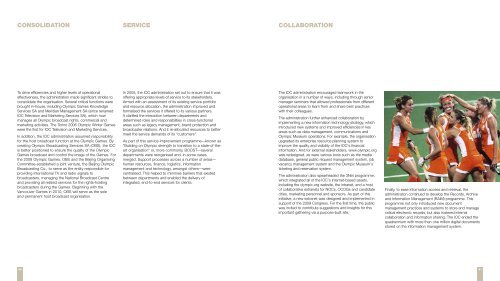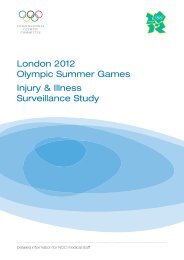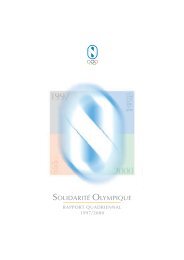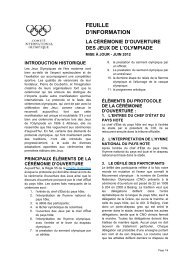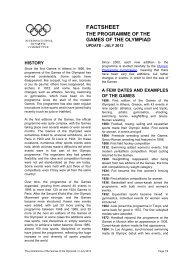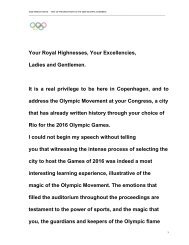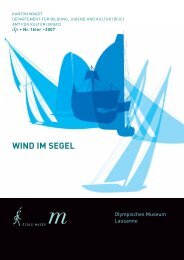3912 reportcomplete final web:layout 1
3912 reportcomplete final web:layout 1
3912 reportcomplete final web:layout 1
Create successful ePaper yourself
Turn your PDF publications into a flip-book with our unique Google optimized e-Paper software.
CONSOLIDATION<br />
To drive efficiencies and higher levels of operational<br />
effectiveness, the administration made significant strides to<br />
consolidate the organisation. Several critical functions were<br />
brought in-house, including Olympic Games Knowledge<br />
Services SA and Meridian Management SA (since renamed<br />
IOC Television and Marketing Services SA), which now<br />
manages all Olympic broadcast rights, commercial and<br />
marketing activities. The Torino 2006 Olympic Winter Games<br />
were the first for IOC Television and Marketing Services.<br />
In addition, the IOC administration assumed responsibility<br />
for the host broadcast function at the Olympic Games. By<br />
creating Olympic Broadcasting Services SA (OBS), the IOC<br />
is better positioned to ensure the quality of the Olympic<br />
Games broadcast and control the image of the Games. For<br />
the 2008 Olympic Games, OBS and the Beijing Organising<br />
Committee established a joint venture, the Beijing Olympic<br />
Broadcasting Co., to serve as the entity responsible for<br />
providing international TV and radio signals to<br />
broadcasters, managing the National Broadcast Centre<br />
and providing all related services for the rights-holding<br />
broadcasters during the Games. Beginning with the<br />
Vancouver Games in 2010, OBS will serve as the sole<br />
and permanent host broadcast organisation.<br />
60<br />
SERVICE<br />
In 2005, the IOC administration set out to ensure that it was<br />
offering appropriate levels of service to its stakeholders.<br />
Armed with an assessment of its existing service portfolio<br />
and resource allocation, the administration improved and<br />
formalised the services it offered to its various partners.<br />
It clarified the interaction between departments and<br />
determined roles and responsibilities in cross-functional<br />
areas such as legacy management, brand protection and<br />
broadcaster relations. And it re-allocated resources to better<br />
meet the service demands of its “customers”.<br />
As part of this service-improvement programme—known as<br />
“Building on Olympic strength to transition to a state-of-theart<br />
organisation” or, more commonly, BOOST—several<br />
departments were reorganised and, in some cases,<br />
merged. Support processes across a number of areas—<br />
human resources, finance, logistics, information<br />
management and technology, amongst others—were<br />
centralised. This helped to minimise barriers that existed<br />
between departments and enabled the delivery of<br />
integrated, end-to-end services for clients.<br />
COLLABORATION<br />
The IOC administration encouraged teamwork in the<br />
organisation in a number of ways, including through senior<br />
manager seminars that allowed professionals from different<br />
operational areas to learn from and share best practices<br />
with their colleagues.<br />
The administration further enhanced collaboration by<br />
implementing a new information technology strategy, which<br />
introduced new systems and improved efficiencies in key<br />
areas such as data management, communications and<br />
Olympic Museum operations. For example, the organisation<br />
upgraded its enterprise resource planning system to<br />
improve the quality and visibility of the IOC’s financial<br />
information. And for external stakeholders, www.olympic.org<br />
was redesigned, as were various tools such as the media<br />
database, general public request management system, job<br />
vacancy management system and the Olympic Museum’s<br />
ticketing and reservation system.<br />
The administration also spearheaded the 3Net programme,<br />
which integrated all of the IOC’s Internet-based assets,<br />
including the olympic.org <strong>web</strong>site, the intranet, and a host<br />
of collaborative extranets for NOCs, OCOGs and candidate<br />
cities, marketing personnel and sponsors. As part of this<br />
initiative, a new extranet was designed and implemented in<br />
support of the 2009 Congress. For the first time, the public<br />
was invited to contribute suggestions and insights for this<br />
important gathering via a purpose-built site.<br />
Finally, to ease information access and retrieval, the<br />
administration continued to develop the Records, Archive<br />
and Information Management (RAIM) programme. This<br />
programme not only introduced new document<br />
management practices and systems to store and manage<br />
critical electronic records, but also fostered internal<br />
collaboration and information sharing. The IOC ended the<br />
quadrennium with more than one million digital documents<br />
stored on the information management system.<br />
61


